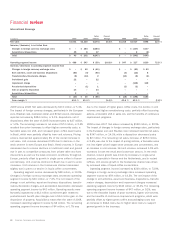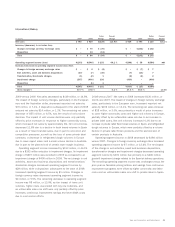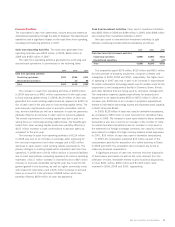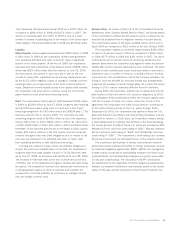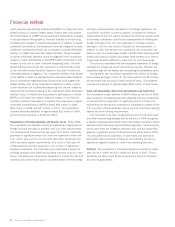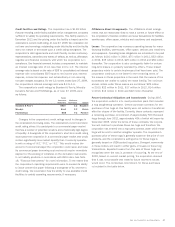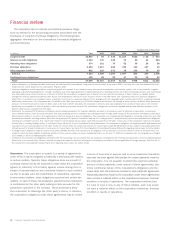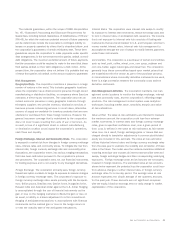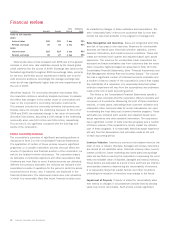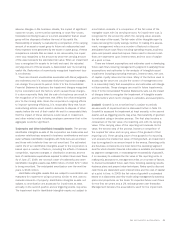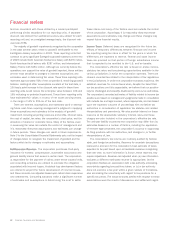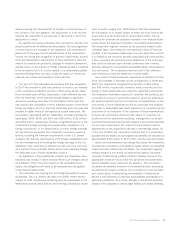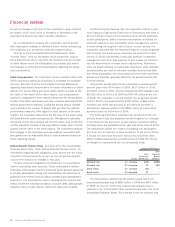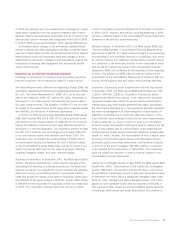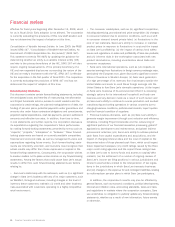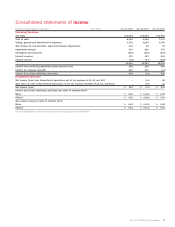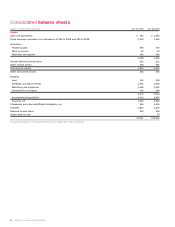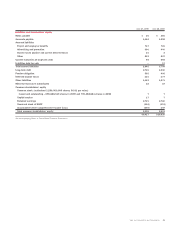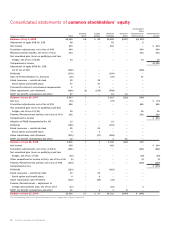Sara Lee 2009 Annual Report Download - page 42
Download and view the complete annual report
Please find page 42 of the 2009 Sara Lee annual report below. You can navigate through the pages in the report by either clicking on the pages listed below, or by using the keyword search tool below to find specific information within the annual report.
Financial review
Time Confidence
In millions Amounts Average Interval Level
Value at risk amounts
2009
Interest rates $26 $29 1 day 95%
Foreign exchange 29 43 1 day 95%
2008
Interest rates $16 $18 1 day 95%
Foreign exchange 35 27 1 day 95%
Interest rate value at risk increased over 2008 due to the general
increase in short term rate volatilities caused by the illiquid global
credit markets over the course of 2009. Exchange rate value at risk
fluctuated significantly throughout 2009 as exchange rates, primarily
for the euro and British pound, experienced volatility due to world-
wide economic problems. Accordingly, the average exchange rate
value at risk was significantly higher than the level experienced at
the end of 2009.
Sensitivity Analysis
For commodity derivative instruments held,
the corporation utilizes a sensitivity analysis technique to evaluate
the effect that changes in the market value of commodities will
have on the corporation’s commodity derivative instruments.
This analysis includes the commodity derivative instruments and,
thereby, does not consider the underlying exposure. At the end of
2009 and 2008, the potential change in fair value of commodity
derivative instruments, assuming a 10% change in the underlying
commodity price, was $13 million and $16 million, respectively.
This amount is not significant compared with the earnings and
equity of the corporation.
Critical Accounting Estimates
The corporation’s summary of significant accounting policies is
discussed in Note 2 to the Consolidated Financial Statements.
The application of certain of these policies requires significant
judgments or a complex estimation process that can affect the
results of operations and financial position of the corporation, as
well as the related footnote disclosures. The corporation bases
its estimates on historical experience and other assumptions that
it believes are most likely to occur. If actual amounts are ultimately
different from previous estimates, the revisions are included in the
corporation’s results of operations for the period in which the actual
amounts become known, and, if material, are disclosed in the
financial statements. The disclosures below also note situations
in which it is reasonably likely that future financial results could
be impacted by changes in these estimates and assumptions. The
term “reasonably likely” refers to an occurrence that is more than
remote but less than probable in the judgment of management.
Sales Recognition and Incentives Sales are recognized when title
and risk of loss pass to the customer. Reserves for uncollectible
accounts are based upon historical collection statistics, current
customer information, and overall economic conditions. These esti-
mates are reviewed each quarter and adjusted based upon actual
experience. The reserves for uncollectible trade receivables are
disclosed and trade receivables due from customers that the corpo-
ration considers highly leveraged are presented in Note 18 to the
Consolidated Financial Statements, titled “Financial Instruments and
Risk Management Interest Rate and Currency Swaps.” The corpora-
tion has a significant number of individual accounts receivable and
a number of factors outside of the corporation’s control that impact
the collectibility of a receivable. It is reasonably likely that actual
collection experience will vary from the assumptions and estimates
made at the end of each accounting period.
The Notes to the Consolidated Financial Statements specify a
variety of sales incentives that the corporation offers to resellers and
consumers of its products. Measuring the cost of these incentives
requires, in many cases, estimating future customer utilization and
redemption rates. Historical data for similar transactions are used
in estimating the most likely cost of current incentive programs. These
estimates are reviewed each quarter and adjusted based upon
actual experience and other available information. The corporation
has a significant number of trade incentive programs and a number
of factors outside of the corporation’s control impact the ultimate
cost of these programs. It is reasonably likely that actual experience
will vary from the assumptions and estimates made at the end
of each accounting period.
Inventory Valuation Inventory is carried on the balance sheet at the
lower of cost or market. Obsolete, damaged and excess inventories
are carried at net realizable value. Historical recovery rates, current
market conditions, future marketing and sales plans and spoilage
rates are key factors used by the corporation in assessing the most
likely net realizable value of obsolete, damaged and excess inventory.
These factors are evaluated at a point in time and there are inherent
uncertainties related to determining the recoverability of inventory.
It is reasonably likely that market factors and other conditions
underlying the valuation of inventory may change in the future.
Impairment of Property Property is tested for recoverability when-
ever events or changes in circumstances indicate that its carrying
value may not be recoverable. Such events include significant
40 Sara Lee Corporation and Subsidiaries


